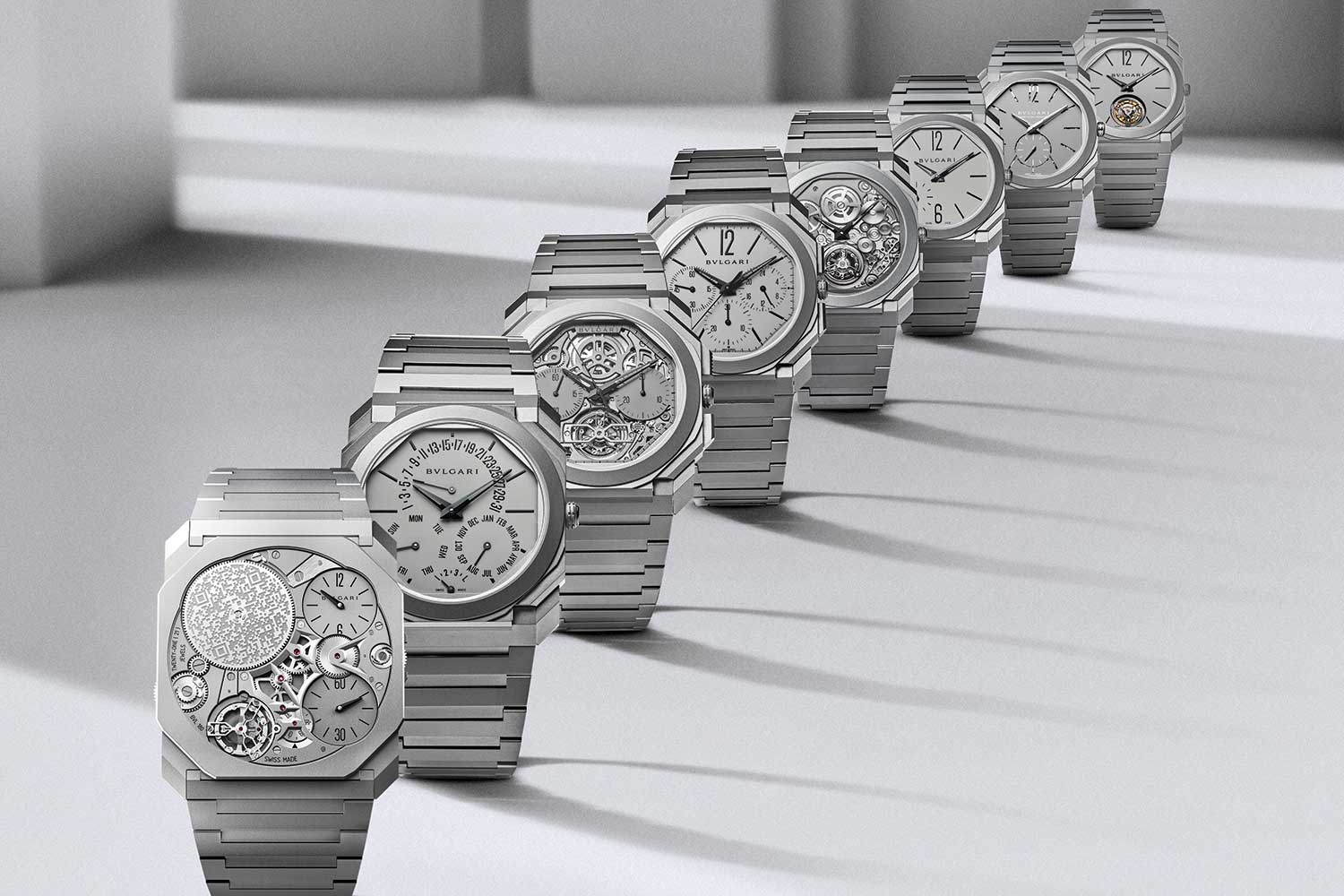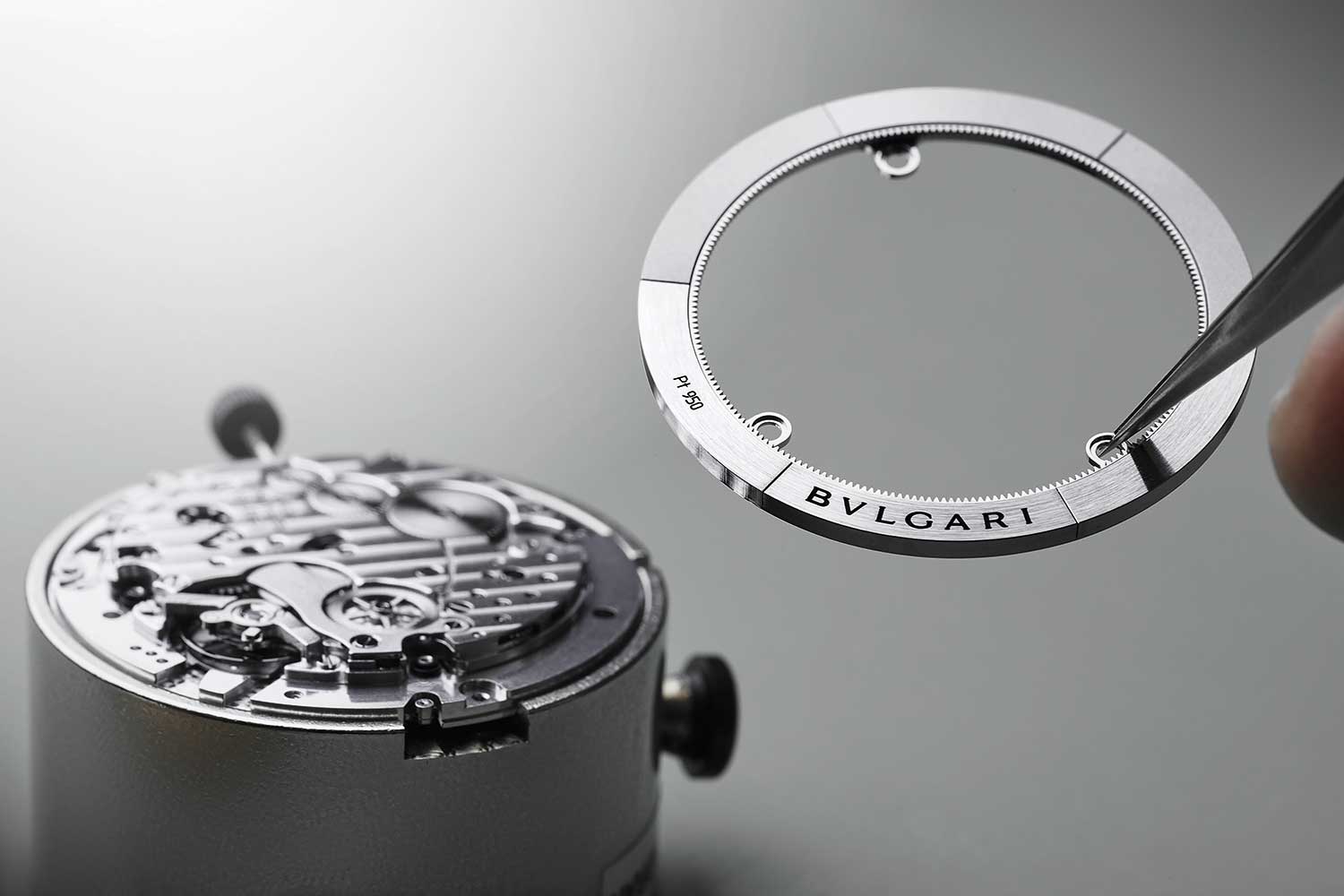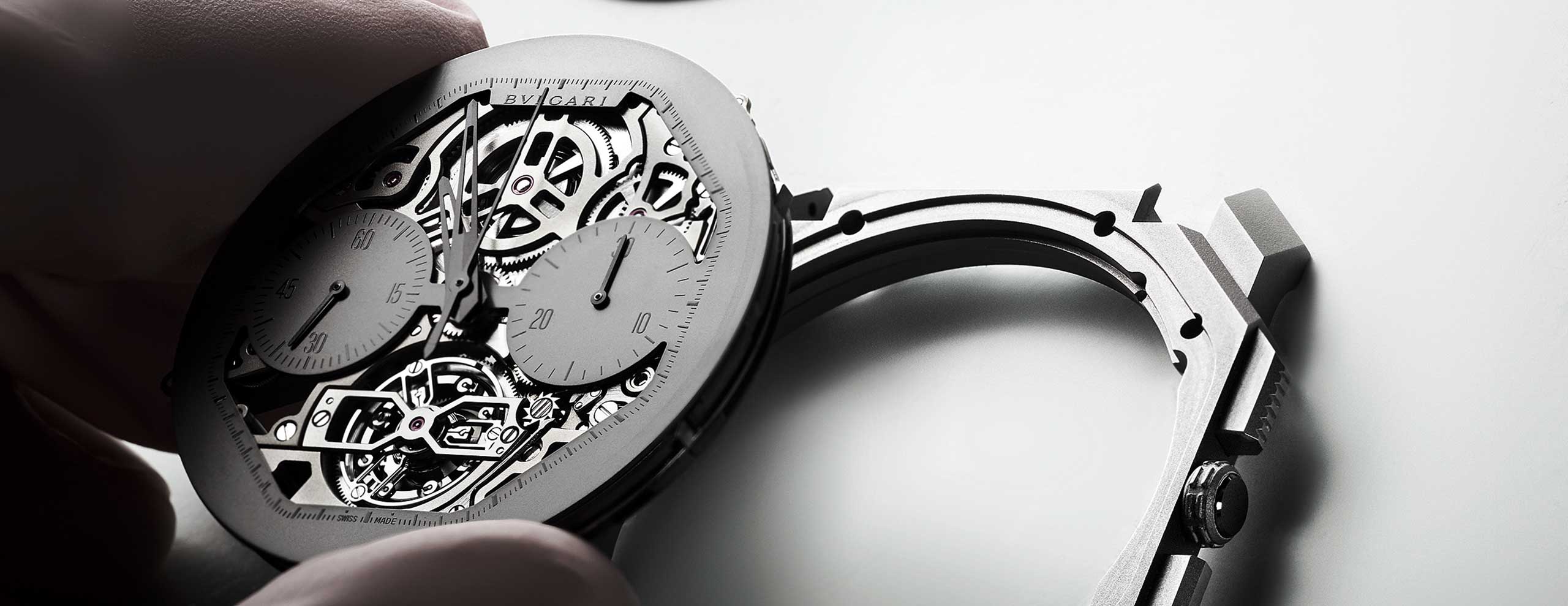Ten years since its introduction, the Bulgari Octo Finissimo is one of the most important and innovative modern watch collections for combining art and technical watchmaking like no other.
“The object is absolutely clear in my mind. For me, the sketch is like a prototype, it’s the beginning of the idea.”
Fabrizio Buonamassa Stigliani would probably rather convey his thoughts with the broad strokes of a pen on paper than with words. As he explains the newest Bulgari watch and reminisces on the Octo Finissimo’s meteoric success, he continually returns to the design process — and, in particular, the sketches where product concepts begin. “It’s the first time you can see an idea,” he says.
As Bulgari’s Executive Director of Product Creation and the man behind the Octo Finissimo’s design, ideating and bringing products to life is his job. In 2024, the Bulgari Octo Finissimo is ten years old, and with the anniversary comes a special edition watch, one with a dial featuring a hand- sketched rendering by Buonamassa Stigliani of the watch’s movement.
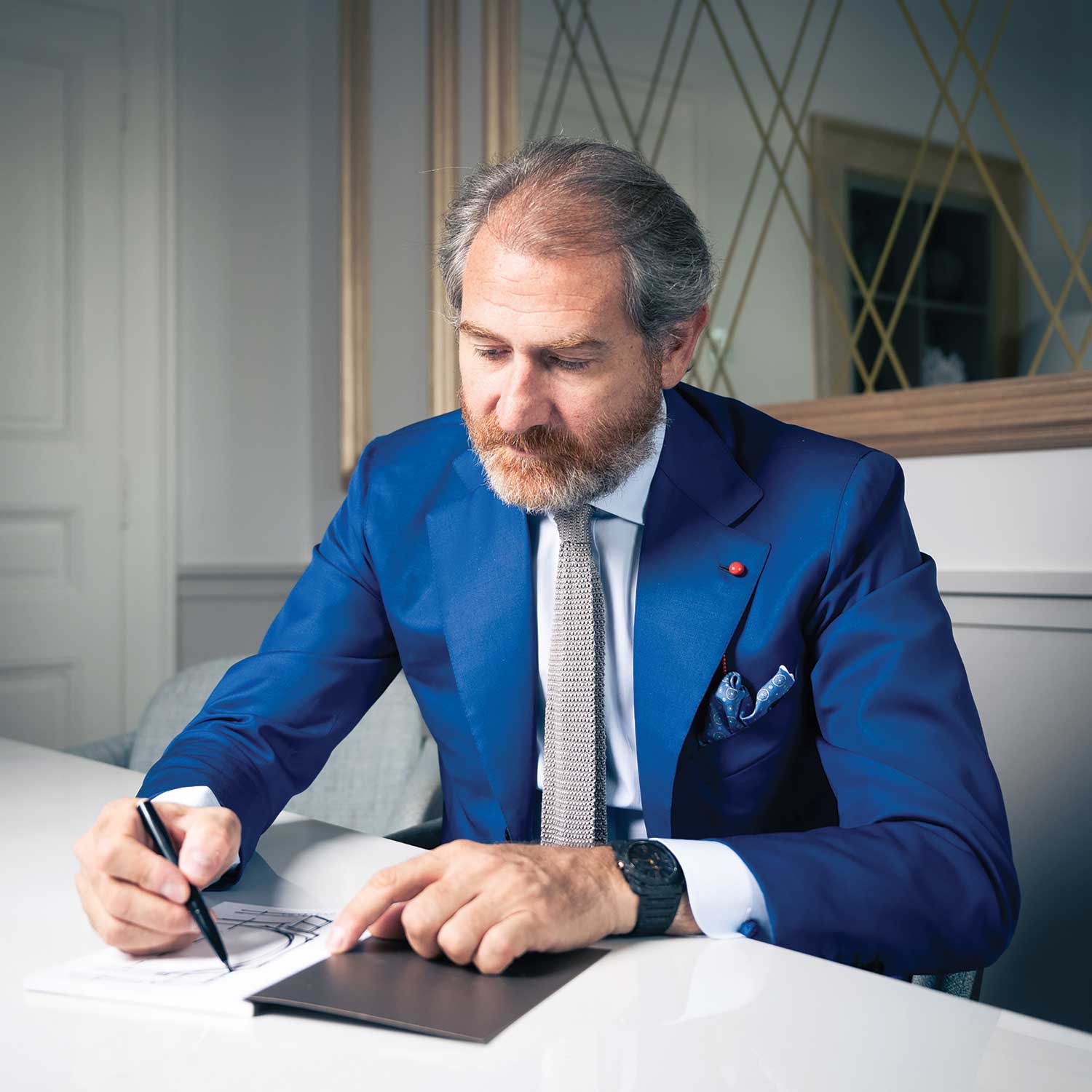
Fabrizio Buonamassa Stigliani is Bulgari’s Executive Director of Product Creation and the man behind the Octo Finissimo’s design
It gives the Octo Finissimo an even more artistic slant, it provides some insight into an oft overlooked facet of watchmaking, and it makes for a visually striking contrast against the case’s perfectly precise finishing.
But a decade into the Octo Finissimo’s reign as Bulgari’s flagship watch, it also serves as a chance to reflect on its remarkable trajectory.
Yes, remarkable: the Octo Finissimo is a runaway success. But where exactly does its mojo come from?
Watch collectors in the know may be able to rattle off a number of reasons: it’s been the vehicle for multiple world records; it’s elevated Bulgari among prestigious watchmakers; it’s crazy thin; and it even boasts a connection to celebrity watch designer Gerald Genta … It’s also just that surprising and captivating, both as a concept and as a design.
You might even call it iconic, as some have, but Buonamassa Stigliani himself doesn’t throw that term around lightly. He’s got a deep perspective on design, as well as on the Octo Finissimo’s origins and evolution — and even if you think you know this watch well, there might be parts of its story that surprise you.
All roads lead to Gérald Genta
Let’s back up a moment. The Octo Finissimo’s origins go back further than the watch’s debut at Baselworld in 2014, or even the moment Buonamassa Stigliani put pen to paper before that. It exists within a wider context of horology and markets and, of course, draws upon a range of influences.
Many would look to 1972 for the source of its inspiration. With the Audemars Piguet Royal Oak which debuted that year, the designer Gerald Genta created an entirely new category of timepieces which reimagined sport watches as elegant luxury items.
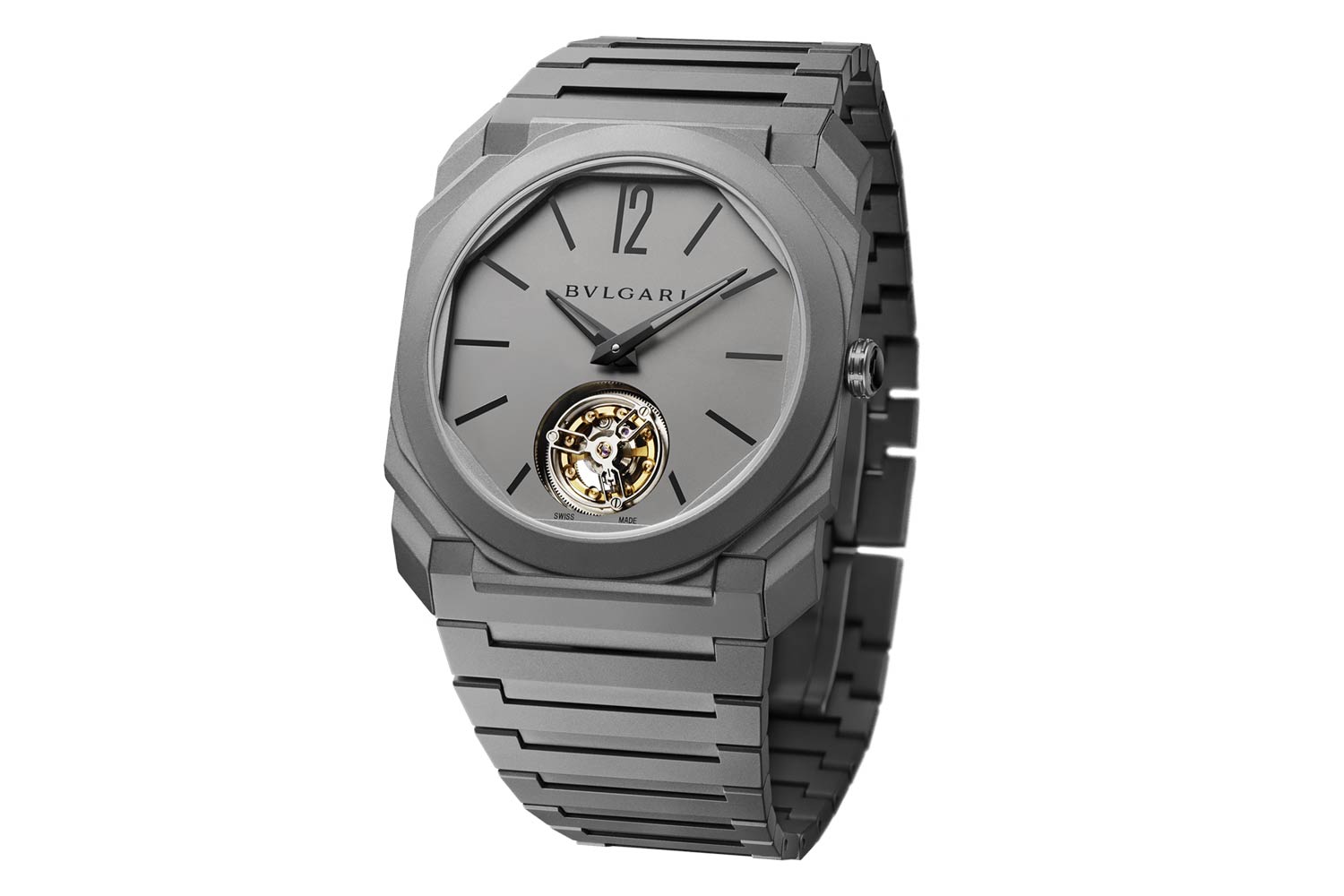
In 2014, Bulgari introduced the incredible manual wind Octo Finissimo Tourbillon with a movement that was a mind-blowing 1.95mm thick, resulting in a case that was 5mm thick.
Its signature traits became iconic and went on to characterize this genre: features like exposed screws, integrated bracelets … octagonal bezels and cases. Gerald Genta wasn’t the first to come up with the idea of using octagonal shapes in watch design, but he most certainly codified it.
In the past, as Buonamassa Stigliani explains, “there was no design to watches. It was just the engineer that created the movement, and afterward someone created the case.
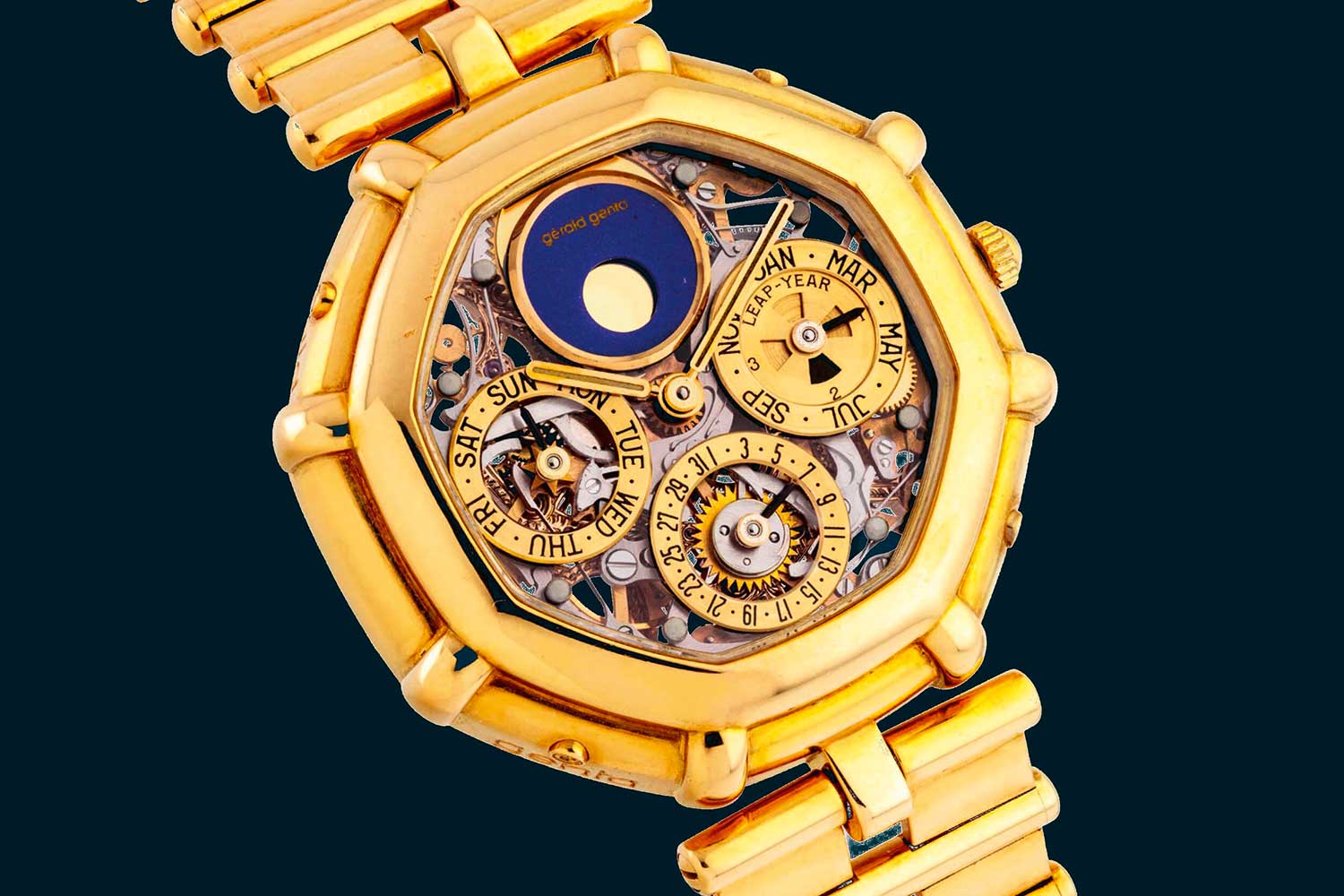
Gérald Genta Octagonal Watch – 1991
“Gerald Genta wasn’t the first [to break the mold], but in the end, he was the right person at the right moment, and he was very lucky.”
Creating the similarly conceived Nautilus for Patek Philippe in 1976 cemented the segment, and the designer’s celebrity. Though the category lacks an agreed upon name or even an established definition, let’s just say: you know it when you see it — and its influence on today’s watchmaking landscape is beyond question.
So many decades later, these watches are at the pinnacle of prestige and hype, and any watch today that benefits from the concept or even echoes its design cues owes some credit to Genta’s genius. There are many.
Octo Origins to Finissimo
Does this explain the design of the Octo Finissimo? Not quite, but it’s part of its story. Before the Finissimo came the Octo with its multifaceted case, but as Buonamassa Stigliani notes, “the Octo’s story is not so easy at all.”
While Genta’s influence and even DNA are integral to the Octo, it’s a common misconception that the distinctive, complicated case design is his. Buonamassa Stigliani is in a position to clarify a little, as he was on the Bulgari team that helped create that first Gerald Genta Octo watch.
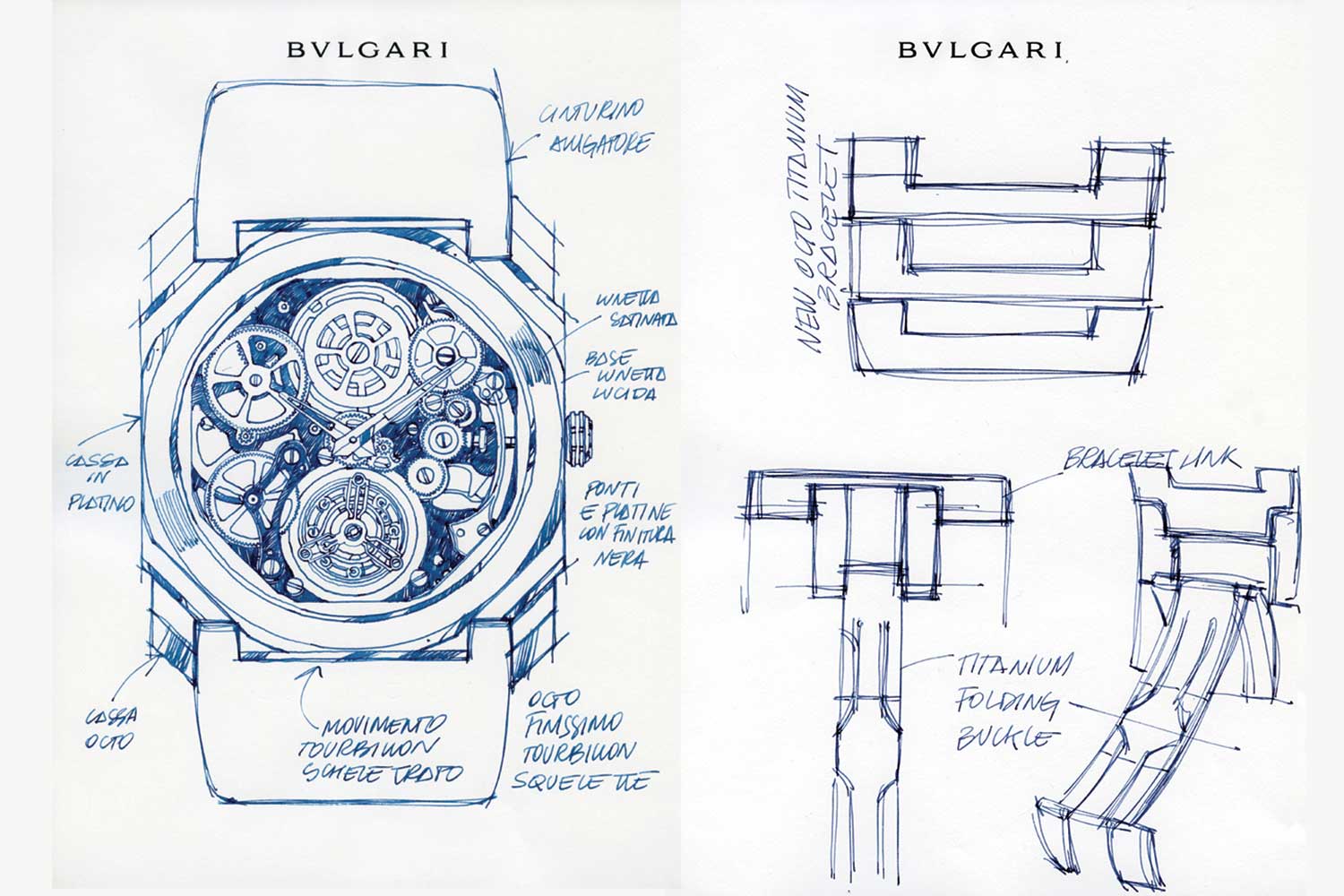
Every Bulgari watch design begins with a hand-sketched concept. It then falls to the brand's engineers and watchmakers to bring it to life
When he joined Bulgari, he says, “it was one of my first tasks: to design the dial and the metal bracelet for the Octo,” while the case was created by the Bulgari team.
Historically, Genta designed watches with octagonal cases, and he even designed the Bulgari Bulgari watch. His connection to the Octo is also sometimes misunderstood because Bulgari purchased the rights to his eponymous brand, Gerald Genta — under which the first Octo watch was created.
But Genta, the man, was no longer directly associated and did not design the watch or the case that would become known as the Octo.
The Octo’s concept was apparently homegrown: “The idea was that we were inspired by the Monete collection designed by Gianni and Nicola Bulgari in the beginning of the ‘70s. It was a coin with a round-shaped chaton and an octagonal base.
“And this is the origin of the Octo Finissimo, its double layered bezel, and the architectural design,” says Buonamassa Stigliani.
The Octo lived under Bulgari’s Gerald Genta brand for a time and was often a vehicle for complicated watchmaking. Eventually, however, the Octo was commuted into the Bulgari brand in phases, first as a Gerald Genta collection and then fully becoming a Bulgari product line.
“We decided to integrate Gerald Genta and Daniel Roth into the Bulgari family, to manage it directly, and we introduced the Octo hour-minute-and-seconds with our base caliber. And this was the first step toward the Octo Finissimo.”
So how do you go from Octo to Finissimo? “We began to clean the Octo design,” Buonamassa Stigliani explains.
“We removed a lot of facets, we removed the backcase, we completely changed the design of the dials, we improved the design of the bracelet … So at the end, it was a brand-new watch.”
One of the Octo’s talking points was that its case comprised 110 facets. “At the beginning, it was a big record. It told you that the case was very difficult to produce,” he adds.
“Today, we don’t count the facets of the Octo any more, we are more concentrated on the savoir faire of the movement and the very unique design.”
The Bulgari Octo Finissimo is many things, and it’s not simply a redesigned Octo. “With the Octo Finissimo we were able to establish a concept, not an aesthetic.”
And part of that concept was rooted in economics and trends of the time it was introduced, as well as the idea of “quiet luxury,” as Buonamassa Stigliani expresses it. “When we talk about design we don’t talk just about shapes and proportions and colors. We talk about the needs of the market.”
Following the Lehman Brothers’ collapse and the financial crisis that followed, many wealthy people were less inclined to show off the likes of large, blingy watches. Though its complicated case was eye-catching, its finishing was characterized by brushed and sand-blasted surfaces.
“It was the right watch at the right moment,” Buonamassa Stigliani says, “because it was able to show that you can wear a grand complication watch even under the cuff of your shirt.”
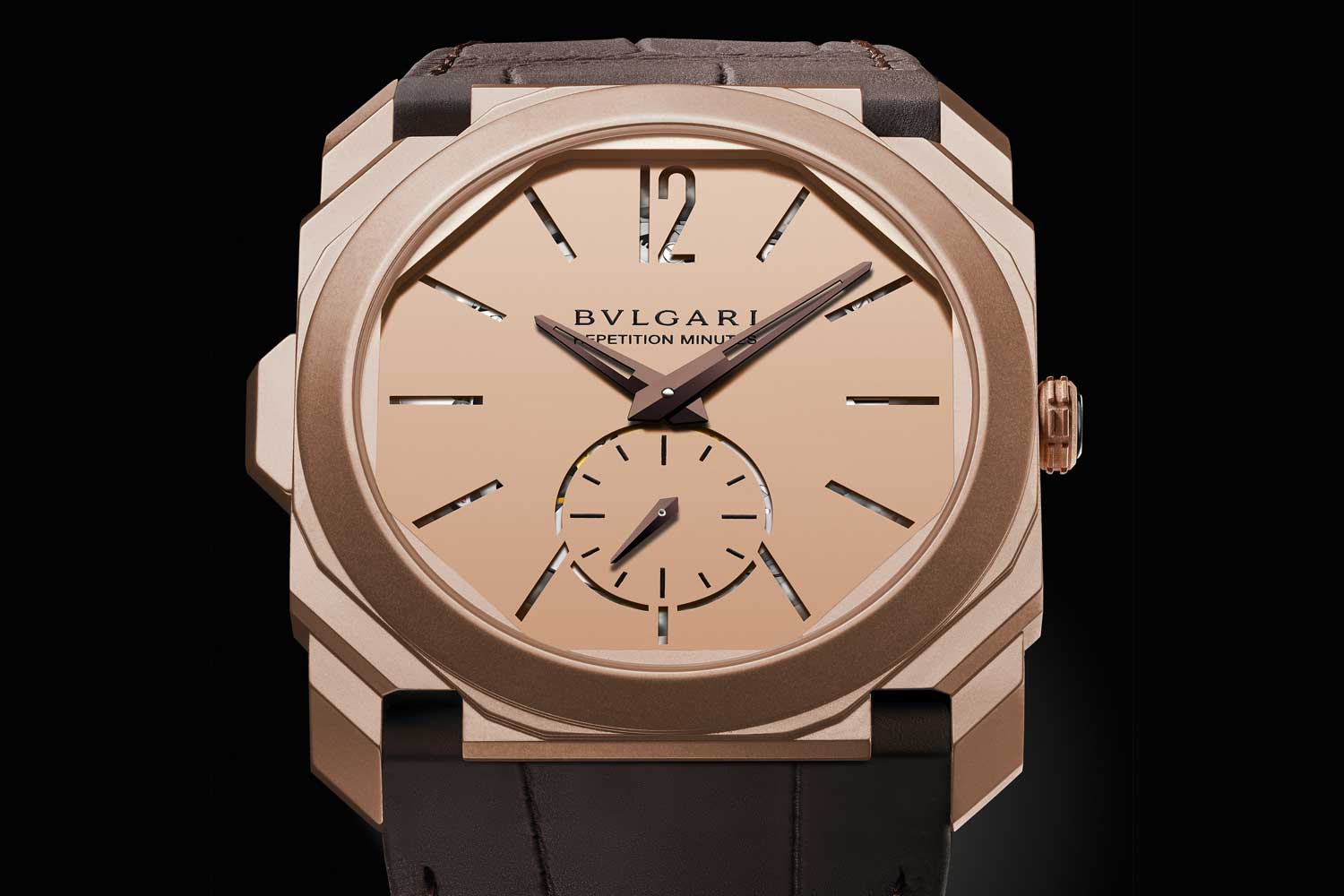
Octo Finissimo Minute Repeater in Sandblasted Rose Gold 103279
Yes, the Octo Finissimo began as a vehicle for complicated horology and is still a showcase for Bulgari’s in-house watchmaking capabilities. The first models featured the likes of tourbillons (2014) and minute repeaters (2016), and right out of the gate it was claiming titles of the thinnest watches in those categories.
But, as Buonamassa Stigliani notes, “the automatic one, it was the game changer.”
With an automatic movement and comparatively simple, time-only functionality, the Octo Finissimo was the thinnest automatic watch in the world when it was introduced in 2017. Unlike grand complication watches, it became the kind of model that the brand could produce in greater volume and which was in reach of more collectors — those that could spend five figures on a watch but not necessarily six.
It was the kind of watch you could wear every day, and it brought Bulgari into competition with established high-end watchmakers.
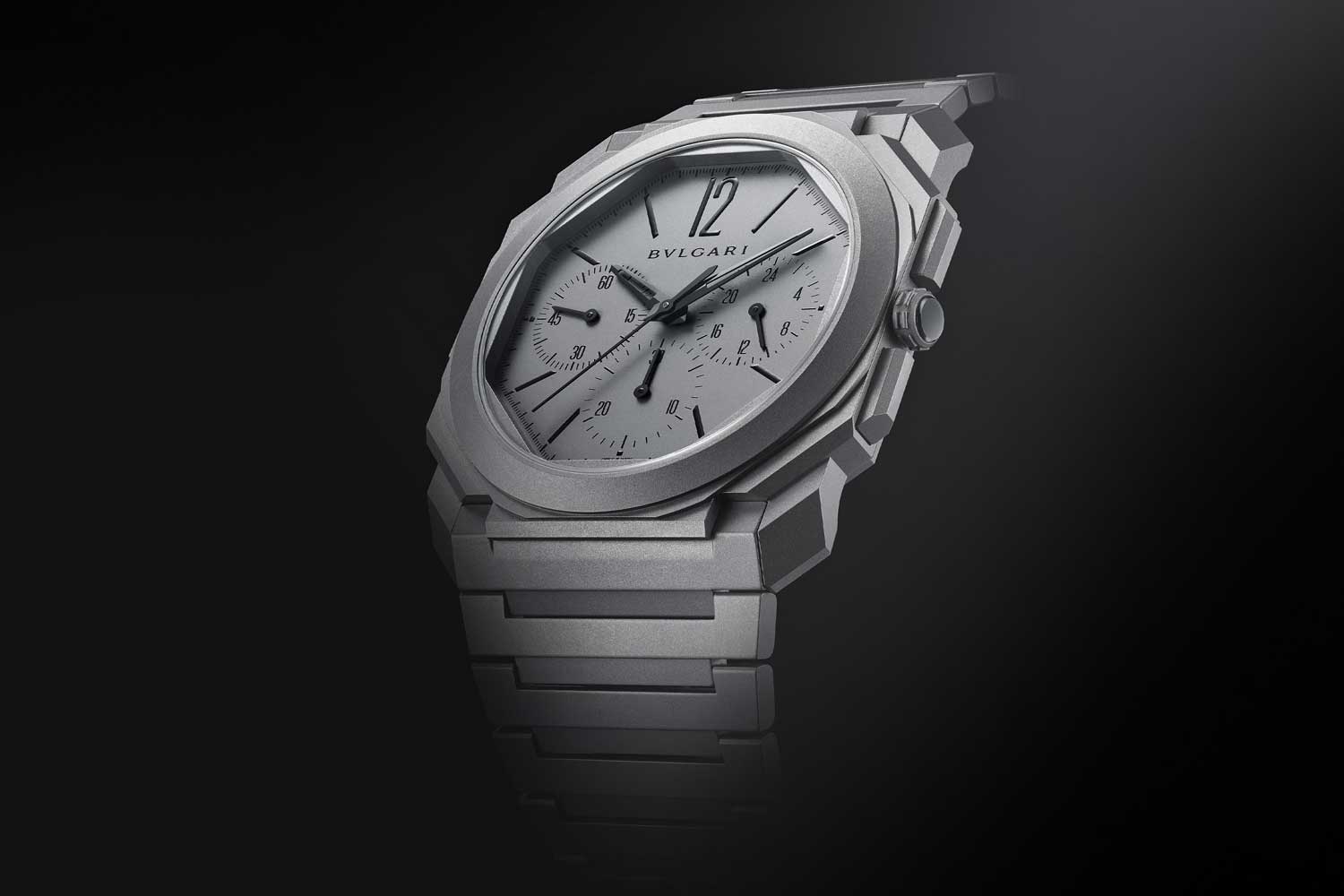
Bulgari Octo Finissimo Automatic Chronograph GMT , 2019
“A lot of very important brands started to follow us. I received a lot of comments during our first presentation in Geneva, and one of the most important managers for a very prestigious brand, very well known for ultra thin watches, approached me to say ‘thank you, because today we have a new challenge.’”
Bulgari went on to win accolades and break records for ultra-thin watches in other categories such as the thinnest automatic chronograph (2019) and later even the thinnest mechanical watch overall at the time with the
Octo Finissimo Ultra (2022). But the Automatic has become the brand’s flagship watch. So, is it an icon?
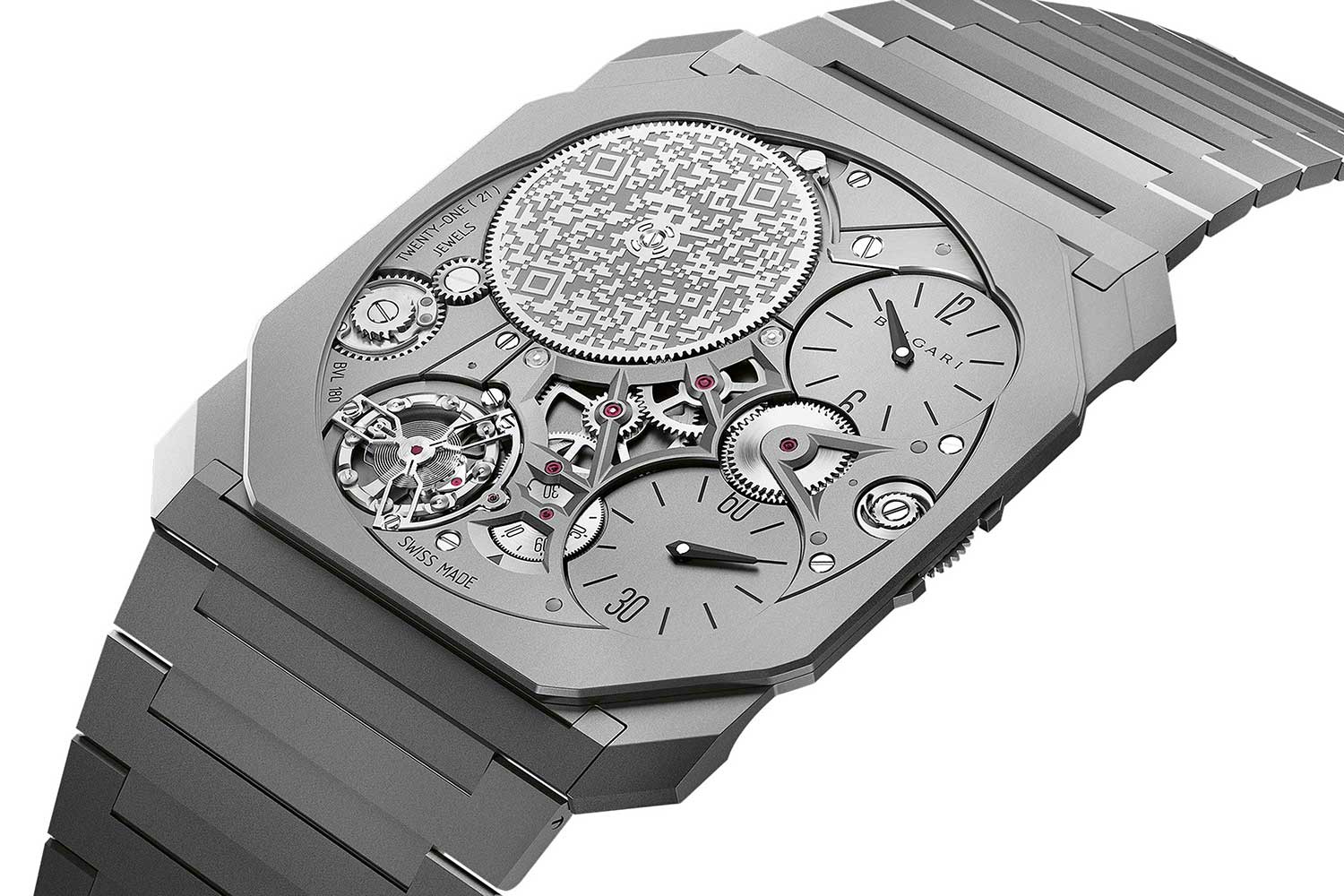
Bulgari Octo Finissimo Ultra, 2022
“No. For me, only the market can tell you in the next 20 years,” says Buonamassa Stigliani.
“After 8 world records, after the Finissimo Ultra, the question that we have and the question that I have is: what will happen in the next 20 years?”
“In Italy we say molto fine.” Buonamassa Stigliani explains to this non-speaker of Italian. “It was a big word in the past to mean that you are very elegant, you are very chic, you’re not a showoff.”
The Italian word “fine” also means thin, of course, so it’s a clever way of naming a watch that would break records among ultra-thin watches as well as become recognized for its distinctive Italian flare. The suffix -issimo is, appropriately, the superlative.
With its striking design and often high-complication movements inside, one might even overlook that thinness is central to the Octo Finissimo’s concept. It’s something that all too many watch brands and designers forget about.
Unless it’s breaking records, a watch’s thinness might be one more detail in a spec sheet — it might not always grab consumers’ attention as much as flashy claims such as, say, extreme water resistance. But consumers certainly appreciate thin watches when they put them on.
“It’s the most difficult thing to do in watchmaking.” Buonamassa Stigliani says. “And maybe nobody was interested in ultra thin watches because the concept was old, it was dusty.”
Aside from everything else that makes it remarkable, one more thing the Octo Finissimo achieved: it made ultra-thin watches cool again. In addition to the comfort a thin watch can offer, it was able to grab headlines and excite the technical side of watch lovers’ brains.
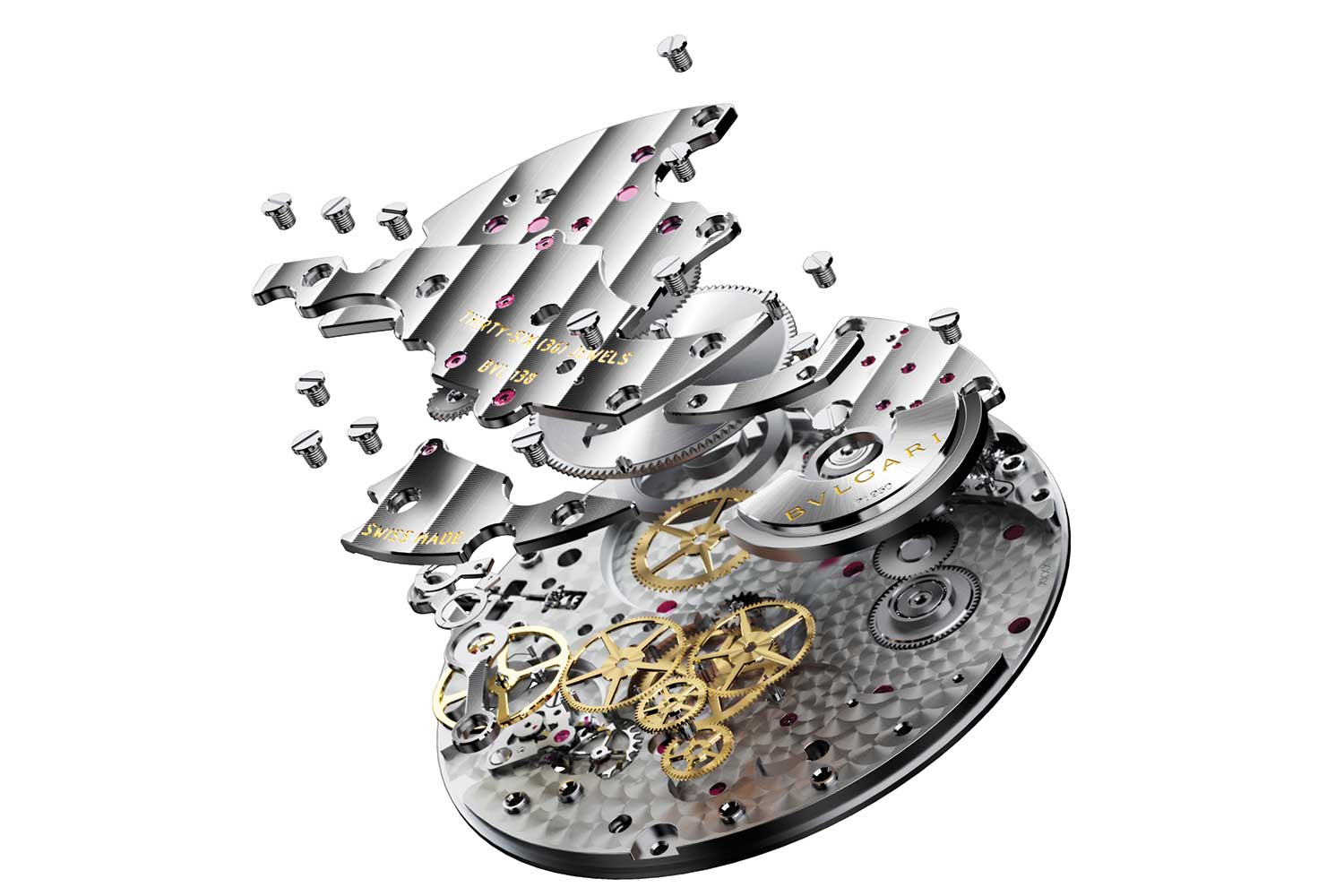
Bulgari caliber BVL 138 is a self-winding ultra-thin movement at 2.23mm.
Many will note, of course, that at some point the thinness of a watch or its movement becomes esoteric. In this niche of paper-thin watchmaking where Bulgari competes among less than a handful of brands, the difference can come down to tenths and even hundredths of a millimeter.
The Octo Finissimo Ultra of 2022 is only 1.8mm thick — about as thick as a US quarter dollar coin (1.75mm). Fitting mechanical clockwork in that space and maintaining structural integrity is kind of mind-boggling, especially when you see it on your wrist.
The world titles show off high-level watchmaking, but ultimately the technology trickles down to impressively thin and ergonomic watches that are accessible to more consumers. The Octo Finissimo Automatic with its 6.4mm thickness is a case in point.
Bulgari Octo Finissimo Sketch Watch
According to Buonamassa Stigliani, it’s Bulgari’s “savoir faire” that’s at the center of the Octo Finissimo’s concept today — in other words, the brand’s technical and watchmaking capabilities. But no one could look at this funkily architectural watch and fail to recognize it as an exercise in style and design — and many would go so far as to say art.
That’s in the eye of the beholder, but as the watch’s designer, Buonamassa Stigliani conveys passionately how artistic self expression is baked into the Octo Finissimo’s concept. The technical precision of watchmaking and the spontaneous creativity of a quick, hand-drawn sketch: they’d seem to be incompatible but come together with intriguing contrast in the brand’s series of limited-edition “Sketch” watches.
The two examples that came before (2022) featured original dial sketches by Buonamassa Stigliani, miniaturized and laser-rendered on actual watch dials. Comparatively imprecise lines of varying shades that reflect the pressure of the designer’s pen on paper formed the indices, subdials and other elements.
The newest model (aptly named
the Sketch watch), however, takes the concept to another level. It leans even more into highlighting the “savoir faire” with, this time, the dial featuring the watch’s hand-sketched clockwork as it’s seen from the watch’s caseback.
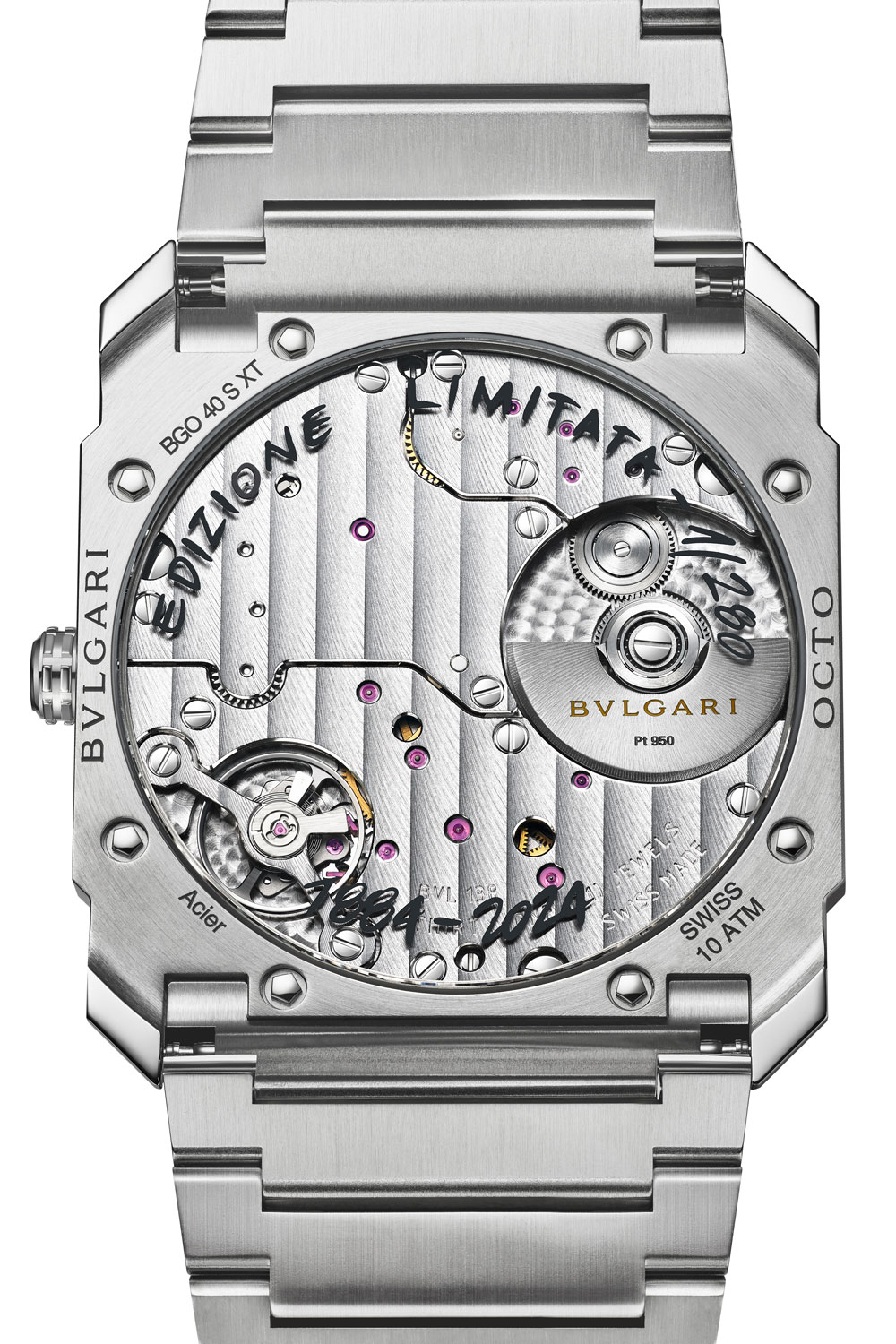
The sapphire case back features commemorative elements embossed in hand-written style
“I don’t remember how many sketches I made,” Buonamassa Stigliani says as he explains developing a design that both looks enough like a sketch to remain visually interesting but also technically accurate.
“I make sketches on paper. And they have to digitize the sketch and remove pixels one by one,” he explains. “The previous Sketch [dial] was made with the laser technique in-house,” he says, “but now the drawing is so precise, so thin, that it was impossible to make with the laser.”
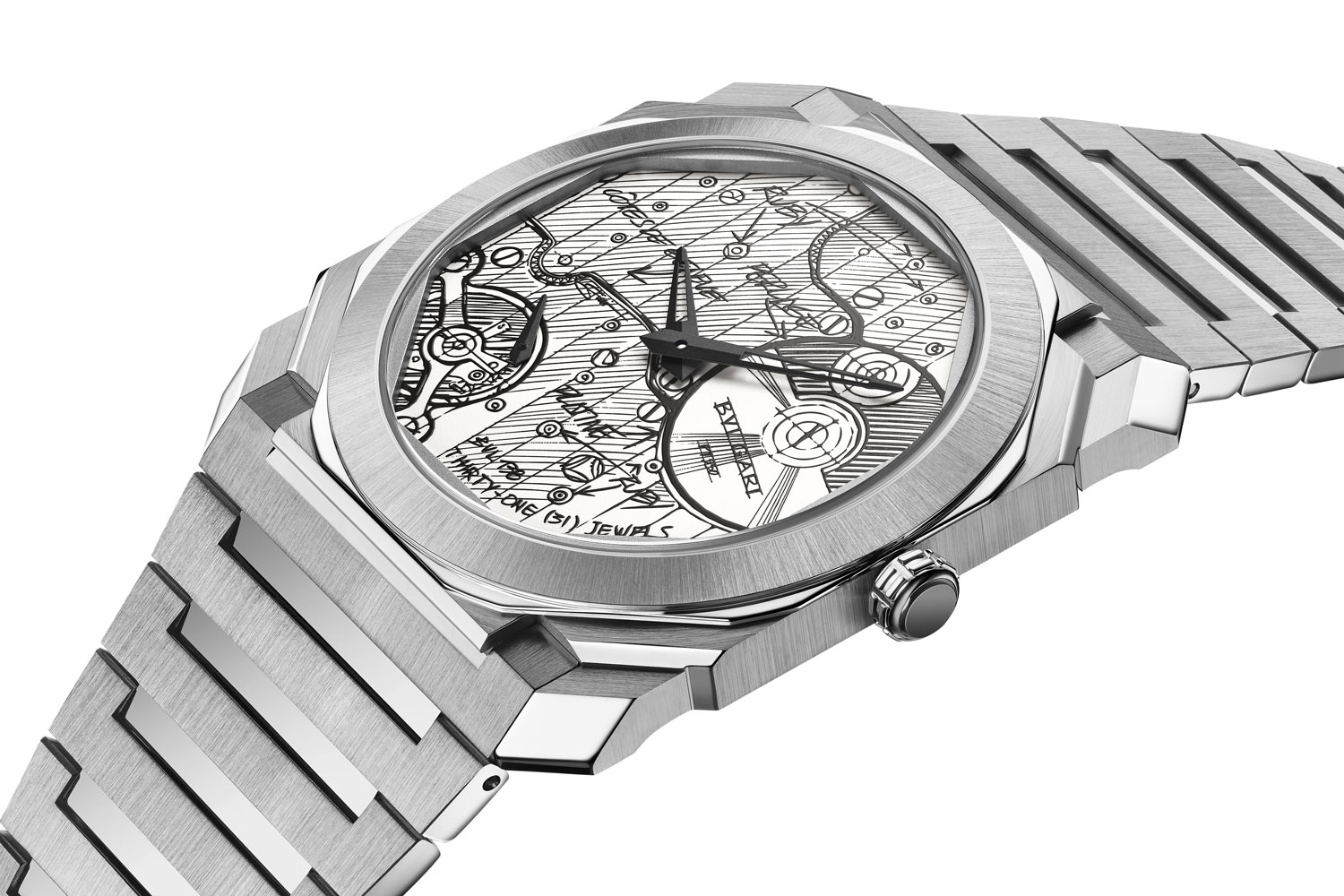
The stainless steel version offers the classic Octo Finissimo aesthetic
The new dial, showing far more detail including different finishes such as Geneva striping and anglage, required pad printing. Next to the precise finishing of the actual watch’s metal facets, the contrast is fascinating.
Evoking paper seems to reference the watch’s thinness, and its whimsical nature injects a personal, human touch. It refers back to the moment that a watch design is conceived — perhaps even the designer’s own reasons behind his chosen career path: “I’ve arrived at the conclusion that I design watches just so I can make another sketch.”

